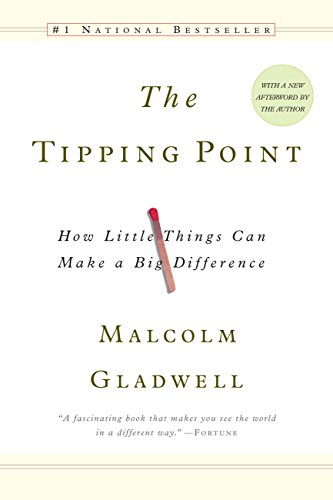

This article is an excerpt from the Shortform summary of "The Tipping Point" by Malcolm Gladwell. Shortform has the world's best summaries of books you should be reading.
Like this article? Sign up for a free trial here .
How do you sell a product, any product, and create something that people can’t get enough of? What you are trying to ignite is a social epidemic, when an idea, message, or product spreads through the public masses like wildfire and creates a craze. This is how to sell a product.
We’ll take a cue from medical epidemics: When a virus spreads, it starts with one person — Patient Zero — who gets sick and infects a handful of others. Then each infected person passes the germs to more people, and with exponential speed and reach the virus spreads until it reaches epidemic proportions. Ideas, messages, behaviors, and products can spread through a population in a social epidemic in the same way that viruses spread. Learn how to sell a product.
How to Sell a Product: Key Principles
We’ll look at how to push ideas or products to a tipping point in order to create a social epidemic. There are three factors that can be adjusted to tip an idea to a social epidemic: the messenger, the message itself, or the context of the message. You can turn your ordinary idea into an epidemic by altering one or more of these aspects.
- The Law of the Few: Certain types of people are especially effective at spreading an infectious idea, product, or behavior.
- The Stickiness Factor: You can change the presentation of a message to make it more contagious and stickier (having a more lasting impact).
- The Power of Context: The environment in which the message or idea is delivered can have a huge impact on whether enough people adopt and spread it to create an epidemic.
How to Sell a Product, Principle #1: The Law of the Few
When you’re trying to spread a message, idea, or product to epidemic proportions, you need people to help preach your message and spread the word to the masses. The Law of the Few proposes that there are certain, special types of people who are much more effective at broadcasting your idea and getting people to listen and follow suit. These special people are exceptional either in their social connections, knowledge, or persuasiveness and fall into three personality types: Connectors, Mavens, and Salesmen. (In the full summary, we’ll look at how these critical personality traits contributed to the success of Paul Revere’s midnight ride.)
Connectors: Social Butterflies
Connectors are people who seem to know everyone. You can find Connectors in every walk of life; they are sociable, gregarious, and are naturally skilled at making — and keeping in contact with — friends and acquaintances.
Connectors tend to be connected to many communities — whether through interests and hobbies, jobs that cause them to work with people in other fields, or other experiences. Their strength is in occupying many different worlds, and bringing them together. You need them when figuring out how to sell a product.
However, Connectors are not close with all their connections. In fact, Connectors’ power is in having lots of acquaintances, or “weak ties.” Your acquaintances typically have different social circles and communities — exposing them to different people and information — than you, whereas your friends’ knowledge and social ties tend to largely overlap with your own. Thus, your friends can help spread a message in the same communities you occupy, but weak ties can help spread that message beyond your reach because they belong to different worlds than you do.
For this reason, weak ties are more valuable than close friends in creating a wider reach for spreading epidemics, and Connectors are the hubs at the center of all those worlds. This is important in knowing how to sell a product.
Mavens: Data Banks
Mavens are also important when considering how to sell a product. While Connectors are people specialists who know many people and can spread information widely, Mavens are information specialists; they are endlessly curious and adept at gathering and retaining information on a wide variety of (sometimes obscure) topics.
A Maven’s influence is in the power of her recommendation. People know that Mavens are knowledgeable and trustworthy sources of information, so a Maven’s word carries a lot of weight. If a Maven suggests you check out a budding epidemic, you’re inclined to listen.
Mavens also love to share their knowledge with other people, and are socially motivated to help people with the information they’ve gathered: A Maven is the kind of person who not only clips coupons and knows when a store is having a sale, but also shares coupons with her friends.
Mavens’ genuine helpfulness inspires more trust and credibility — people know Mavens have no agenda or ulterior motive — so when they give recommendations people tend to take them more seriously. In a social epidemic, they serve as data banks — they carry the message, with authoritativeness. This critical when deciding how to sell a product.
Salesmen: Persuaders
Finally, you need salesmen to sell your product. Salesmen are the people who pitch the idea or message behind an epidemic and persuade people to jump on board. They do not merely store and share information; Salesmen want to convince you to follow their advice.
Salesmen have the right words plus an inherent energy, enthusiasm, charm, and likability that makes people want to listen to them. Plus, Salesmen instinctively know how to use nonverbal cues to reinforce their power of persuasion.
Nonverbal communication — including facial expressions, tone of voice, eye contact, and body language — have a powerful impact on us, even when they are so subtle that we don’t notice them. People naturally fall into a conversational rhythm when they talk, subconsciously matching speech cadence, tone, and volume. The better your conversational harmony with someone, the more connected you feel to them.
Salesmen are masters at not only matching conversational rhythms, but drawing people into their own rhythms and setting the tone for the interaction. This natural ability makes Salesmen particularly skillful at influencing people’s emotions and thus persuading them to join a movement or buy a product. You need this skills when strategizing about how to sell a product.
Employ the Law of the Few
As Malcolm Gladwell illustrates with his varied examples, social epidemics take many forms — from fashion crazes to rumors to crime waves — and each calls for a unique combination and application of the three principles he discusses. Not every principle will be applicable to a given epidemic, and similarly, not every messenger will be effective. The key in understanding how to sell a product is to understand how these strategies can be employed so that you can determine what’s most effective in your situation.
(Shortform note: Overall, the book doesn’t offer much — if any — general tips for applying of these strategies, presumably because each situation is so unique. Instead, Gladwell focuses on driving home understanding of the principles based on research, his explanations, and case studies.)
How to Sell a Product, Principle #2: The Stickiness Factor
The Law of the Few declares that the right messengers can tip and spread an epidemic. However, your messengers can only succeed when the message is one that will catch on — in other words, it must be “sticky,” meaning that it must be memorable enough to inspire action or change. If you don’t remember the message, what are the chances you will change your behavior or buy the product? This is crucial to understanding how to sell a product.
If an idea or product isn’t catching on, don’t assume that it’s inherently unsticky. Generally, it’s just the presentation of the message that must be tweaked to make it sticky.
This doesn’t mean you have to make the message loud or in-your-face to make it sticky; in fact, small, subtle changes are often the key to stickiness. In one example, a researcher distributed pamphlets trying to influence Yale students to get free tetanus shots at the campus health center. Details and photos emphasizing the danger of the disease had virtually no impact, but adding a campus map, circling the health center, and adding the hours the shots were available produced results. Adding information that was more practical and personal made the message sticky.
You have to know your audience to determine how to make information sticky for them and learn how to sell a product; it may require tapping into their interests or subconscious motivation. The forces that inspire people to act are not always intuitive, so sometimes market or scientific research can be useful in developing sticky strategies.
How to Sell a Product, Principle #3: The Power of Context
The third principle to keep in mind when determining how to sell a product has to do with the conditions that lend themselves to an epidemic catching on. The Power of Context capitalizes on the fact that human behavior is greatly affected by the context of our environments, and that altering the physical environment or social context in which people receive your message can make them more receptive to it. Even subtle, seemingly insignificant changes in our environments can make us more likely to change our behavior. When done on a broad enough scale, this can ignite an epidemic.
Environmental Context: Scenery Affects Behavior
One way of manipulating context is to alter the physical environment in some way. This is important in learning how to sell a product. The New York City police used the Power of Context by implementing the Broken Windows Theory to reduce violent crime by cracking down on smaller infractions, including diligently cleaning graffiti on subway trains. The basis of this idea is that subtle environmental cues — like graffiti-covered subway trains — send a message that anything goes, and that mindset snowballs into more serious crimes.
(Shortform example: If you are in a public restroom that’s smelly, unkempt, and littered with crumpled seat covers and used paper towels, you’re less inclined to pick your paper towel up and put it back in the trash if it falls to the ground. On the other hand, if the restroom is spotlessly clean, you’ll probably feel more self-conscious about your paper towel litter, and you’re more likely to pick it up and put it back in the trash can.)
Social Context: We Act Differently In Different Circumstances and Social Settings
People are also influenced by social context. In fact, studies reveal that your character is not a fixed set of inherent traits, but a collection of habits and tendencies that are subject to change under different conditions and context. This makes context so powerful that certain situations can eclipse our natural dispositions.
On a small scale, you probably behave differently whether you’re with your family, your coworkers, or your old college friends. You’re also likely to act differently in public than you do in the privacy of your home. Is this effect powerful enough to determine whether you follow a fashion trend or join a social movement? Peer pressure is something to consider–and take advantage of–when considering how to sell a product.
Small groups, in particular, have a strong power to amplify a message or idea and help create an epidemic for a few reasons.
- The power of group influence is stronger when each member of the group knows her fellow group members (e.g. you care more about what your friends and family think of you than strangers’ opinions).
- Humans have a mental and emotional limit to the number of social relationships they can maintain, so the size of these groups must be within that limit in order to have that relational level of social influence.
- People rely on each other for division of labor and division of knowledge in order to work more efficiently in groups. This creates a network of interconnectedness and influence.
On a community level, people have a capacity to have some kind of social relationship with about 150 people. In a community of 150 or less, people know everyone well enough to keep each other accountable to get work done, to abide by social standards, and to follow other group policies and norms. Groups of this size are better able to reach consensus and act as one. Beyond that limit, smaller groups start to break off and organizational hierarchies (e.g. management structures in companies) may be needed to keep order. When figuring out how to sell a product, don’t let your organization get too big.
———End of Preview———

Like what you just read? Read the rest of the world's best summary of "The Tipping Point" at Shortform . Learn the book's critical concepts in 20 minutes or less .
Here's what you'll find in our full Tipping Point summary :
- What makes some movements tip into social epidemics
- The 3 key types of people you need on your side
- How to cause tipping points in business and life






